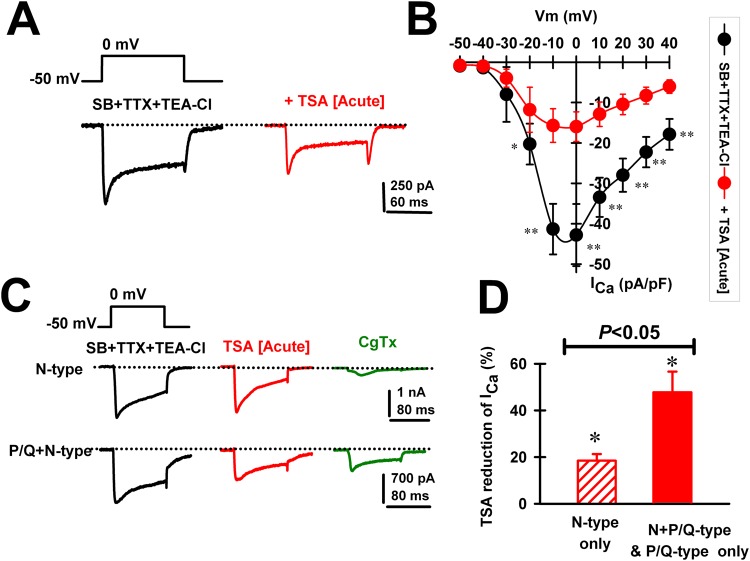Figure 2.
Effects of acute TSA (1 μM) on voltage-dependent Ca2+ currents (ICa) in different PPN cell types. (A) Representative ICa recorded using a 100 msec long depolarizing square step from a holding potential of −50 mV to 0 mV before (black record) and after (red record) acute bath application of TSA (1 μM). (B) Standard current-voltage (I-V) relationship of ICa before (black circles; n = 8 PPN neurons), and after TSA (20 min; 1 μM, red circles, n = 8 PPN neurons). *p < 0.05, **p < 0.01 One-way ANOVA, Bonferroni post-hoc test comparing SB + TTX vs acute TSA (1 μM). Note significant decreases in ICa after TSA from −20 mV to 40 mV. (C) Representative ICa recorded from a N-only PPN and a N + P/Q PPN neuron using a 100 msec long depolarizing square steps from a holding potential of −50 mV to 0 mV in the presence of SB, TTX and TEA-Cl (black record), after acute bath application TSA (15 min., 1 μM; red record), and after ω-conotoxin GVIA (20 min., CgTx, 2.5 μM, green record) to block N-type channels. Note marked effect on the N-only cells, but partial effect on the N + P/Q cell. (D) Percent reduction in ICa amplitude by TSA (1 μM) in a group of PPN cells expressing only N-type (n = 7; dashed red bar), or P/Q-type (n = 10; solid red bar) Ca2+ channels. *p < 0.05 significant reduction of ICa by acute bath application of TSA for N-only PPN neurons (Paired Student’s t-test; n = 7; df = 6; t = −3.62; p = 0.015), or PPN cells expressing P/Q-type channels (i.e., P/Q-only plus N + P/Q types) (paired Student’s t-test; n = 10; df = 9; t = −2.74; p = 0.029). One-way ANOVA comparison of both groups showed significant differences (F(1,15) = 7.2; p < 0.05; Bonferroni’s post-hoc t-test, t = 2.68, p = 0.02).

